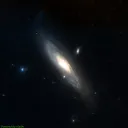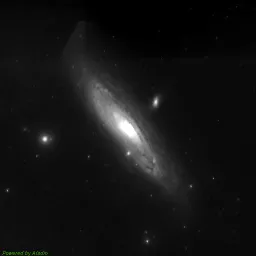Andromeda Galaxy (M31) Observation Details

M31 Daily Motion
M31 will be visible until March, 10, when it will move too close to the Sun. During this time, its proximity to the Sun will cause it to disappear from the night sky, making it unobservable for a while.
M31 Visibility Timetable on December 28
M31 Rise and Set Timetable
| Time | Elevation | |
| Moon Rise, 50.4% illuminated | 09:48 | 18° |
| Sunset | 14:55 | 73° |
| Civil sunset | 15:26 | 78° |
| M31 transit | 16:23 | 86° |
| Astrosession begin | 16:31 | 86° |
| Moon Set | 22:52 | 19° |
| M31 set | 01:10 | |
| Astrosession end | 03:47 | -11° |
| M31 rise | 07:32 |
Track M31 Position Throughout the Night
← Sun, 28 December 2025 →
| Time | |
| Altitude | |
| Azimuth |
Where is Andromeda Galaxy right now?
Andromeda Galaxy (M31) is located in the constellation Andromeda, at right ascension 00h 42m 44s" and declination 41° 16' 08s. At the current time, it is below the horizon and not visible from your location.Andromeda Galaxy (Messier 31): The Nearest Spiral Neighbor to the Milky Way
The Andromeda Galaxy (Messier 31 or M31) is the closest large spiral galaxy to the Milky Way and one of the most distant objects visible to the naked eye. Located about 2.54 million light-years away in the constellation Andromeda, it stretches across more than 220,000 light-years, making it twice the size of our own Galaxy. With an estimated one trillion stars, Andromeda is the largest member of the Local Group of galaxies, which also includes the Milky Way, the Triangulum Galaxy (M33), and about 50 smaller dwarf galaxies.
Appearance and Structure
The Andromeda Galaxy is a barred spiral galaxy, featuring a bright central bulge and beautifully defined spiral arms filled with star-forming regions, nebulae, and dust lanes. When viewed through a telescope or long-exposure photograph, Andromeda displays a glowing core surrounded by faint spiral arms that extend across more than 3 degrees of the sky — roughly six times the apparent width of the full Moon.
Distance and Brightness
At a distance of 2.54 million light-years, Andromeda’s light takes more than two million years to reach Earth. Its apparent magnitude of 3.4 makes it visible even without a telescope under dark skies. In binoculars, it appears as an elongated fuzzy patch; with small telescopes, observers can spot its two companion galaxies, M32 and M110.
A Future Collision with the Milky Way
Astronomers have determined that the Andromeda Galaxy is moving toward the Milky Way at a speed of about 110 km/s (68 miles/s). In roughly 4 to 5 billion years, the two galaxies are expected to collide and merge, forming a giant elliptical galaxy sometimes called “Milkomeda.” Despite the dramatic name, individual stars are so far apart that few, if any, will collide directly — the event will be a graceful gravitational dance on a cosmic scale.
Scientific Importance
Studying Andromeda provides crucial insights into galaxy formation, dark matter distribution, and star evolution. Because it’s similar in structure to the Milky Way, astronomers use M31 as a cosmic mirror to understand our own galaxy’s history and future.
M31 Image Gallery
DSS Blue

DSS Red

DSS Near-Infrared

DSS Composite image

The photos are taken from the Digitized Sky Survey 2 (DSS2), which was produced at the Space Telescope Science Institute (STScI) under NASA contract, using data from the UK Science and Technology Facilities Council (STFC), the European Southern Observatory (ESO), and the National Geographic Society-Palomar Observatory Sky Survey (POSS II).
Special thanks to the National Optical Astronomy Observatory (NOAO), the Royal Observatory, Edinburgh, and the California Institute of Technology for their significant contributions.
Finder Chart for M31
| Object name | M31 |
| Field of view | |
| Limiting magnitude | |
| M31 coordinates | 0.71232, 41.26906 |
| Center coordinates | 0.71232, 41.26906 |
How to Find the Andromeda Galaxy
You can locate Andromeda in the autumn and winter skies of the Northern Hemisphere. Find the W-shaped constellation Cassiopeia, which points downward toward Andromeda. The star Schedar (α Cassiopeiae) marks the lower tip of this deep V (↓) shape. From Schedar, follow the direction of the V downward toward the bright star Mirach (β Andromedae) in the constellation Andromeda. The galaxy lies slightly above and to the left of Mirach, appearing as a faint, misty oval under dark skies. It’s best observed on moonless nights far from city lights.
M31 Passage Through Night
Current position of M31
| Time | 07:41 |
| Latitude | 37.3541 |
| Longitude | -121.955 |
| M31 elevation | 1° |
| M31 Azimuth | -35° |
Annual motion of M31
| Date | Sun, 28 December 2025 |
| Twighlight start | 16:26 |
| Twighlight end | 03:41 |
| Twighlight duration | 11h 15m |
| Rise | 07:32 |
| Set | 01:06 |
| Elevation at transit | 86° |
| Transit time | 16:19 |
| Equatorial coordinates | RA: 00h 42m 44s", Dec: 41° 16' 08s |
| Magnitude | 3 |
| Constellation | Andromeda |
The graph is structured with the vertical axis showing the hours of the day, ranging from 12 AM to 12 AM the next day, while the horizontal axis spans each day of the year.
The reddish shaded area indicates the periods when the M31 is above the horizon, visible to observers. The white line marks the times when the celestial object reaches its highest point in the sky each day, known as the transit.
Astrometric & Physical Parameters of M31
Coordinates & Visibility
| Right Ascension | 0.71232° |
| Declination | 41.26906° |
| Magnitude | 3.44 |
| Constellation | Andromeda |
| Elevation | 0.6° |
| Azimuth | -34.7° |
Data Credits
The nebulae information on this page is sourced from the OpenNGC project, developed by Matteo Verga. OpenNGC provides detailed data on the NGC catalog, which is a valuable resource for exploring deep-sky objects such as nebulae.
For more details or to contribute to OpenNGC, visit the official GitHub repository: OpenNGC on GitHub.
